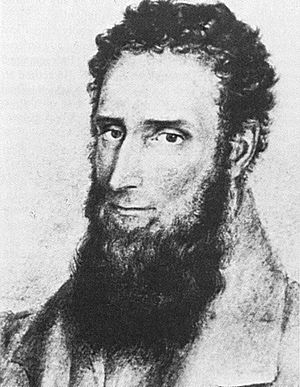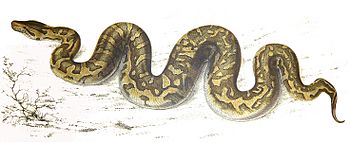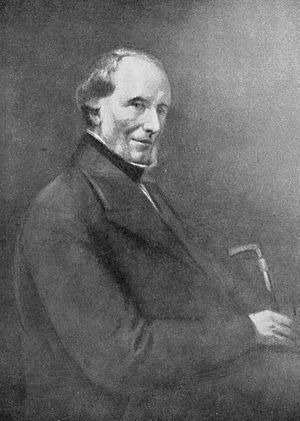Andrew Smith (zoologist) facts for kids
Quick facts for kids
Sir Andrew Smith
|
|
|---|---|

Sir Andrew Smith
|
|
| Born | 3 December 1797 Hawick, Roxburghshire
|
| Died | 11 August 1872 (aged 74) |
| Nationality | British |
| Alma mater | University of Edinburgh |
| Scientific career | |
| Fields | |
| Author abbrev. (zoology) | A. Smith |
Sir Andrew Smith (born December 3, 1797 – died August 11, 1872) was a British doctor, explorer, and scientist. He studied animals (a zoologist) and different cultures (an ethnologist). He is often called the "father of zoology" in South Africa. This is because he discovered and described many animal species there. He wrote about them in his important book, Illustrations of the Zoology of South Africa.
Smith was born in Hawick, Scotland. He became a doctor at the University of Edinburgh in 1819. Before that, he had joined the Army Medical Services in 1816.
Contents
Adventures in South Africa (1820–1837)
In 1820, Andrew Smith was sent to the Cape Colony in South Africa. He went to Grahamstown to look after the health of soldiers. In 1822, he became the main doctor for the Albany district. He also opened the first free clinic for people who couldn't afford medical care.
Smith loved nature and learning about people. He led a science trip into the country's interior. He was often sent by governors on secret missions. These missions involved visiting different tribes beyond the colony's border. For example, in 1824, he visited Kaffraria. He wrote many notes about the customs of the Xhosa people.
In 1825, the Governor of the Cape Colony, Lord Charles Somerset, made Smith the first leader of the South African Museum. This museum was for natural history in Cape Town.
In 1828, Smith traveled to Namaqualand. He was sent to report on the Khoisan people living there. Because of this trip, he wrote a book called On the origin and history of the Bushmen in 1831.
Later in 1831, there were rumors of trouble in the east. Governor Sir Lowry Cole sent Smith to Natal in January 1832. There, he met with Dingaan, a powerful leader. Smith's report back to the governor caused a lot of interest. His report helped Britain decide to take over Port Natal in 1844. It then became a British colony.
In 1833, Smith went on another long trip. This 18-month expedition went north of the Orange River. He traveled to Basutoland, Kuruman, and even to the Magaliesberg mountains. Charles Davidson Bell went with him as the expedition's artist. Smith returned with two important leaders from Mzilikazi's group. These leaders made an agreement with the Cape Colony. Smith's report about this trip was published in 1836. His detailed diary was later published in 1939–40.
Meeting Charles Darwin
When the famous ship Beagle visited the Cape in May 1836, Smith met a young scientist named Charles Darwin. Smith showed Darwin different rock formations. He also gave Darwin some rock samples he had collected. These samples are now in a museum.
Darwin and Smith wrote letters to each other. They talked about how large animals in South Africa could live on very little food. This helped Darwin understand that a lack of lush plants didn't explain why giant creatures had died out. Darwin often mentioned Smith in his writings. He also helped Smith become a member of the important The Royal Society in 1857.
Life in Britain (1837–1872)

Smith went back to the United Kingdom in January 1837. Soon after, he started publishing his big work, Illustrations of the Zoology of South Africa. This book had five volumes and was published between 1838 and 1850.
He quickly moved up in the army medical service. In 1841, he became a main medical officer at Fort Pitt, Chatham. In 1844, he married Ellen Henderson and became a Roman Catholic like her. In 1845, he became an assistant to Sir James McGregor, 1st Baronet. Sir James was the head of the army medical department. Smith took over as Director-General of the Army Medical Services in 1853.
Smith was in charge of organizing medical services during the Crimean War. There were some questions about how well things were managed. However, an investigation found that he had done his job well. He received many awards from universities and scientific groups. Due to poor health, he had to retire in 1858. He was then given the title Knight Commander of the Bath.
See also
 In Spanish: Andrew Smith (zoólogo) para niños
In Spanish: Andrew Smith (zoólogo) para niños- Category:Taxa named by Andrew Smith (zoologist)
Animals Named After Andrew Smith
Andrew Smith is honored in the scientific names of several animals. These include three types of reptiles:
- Gekko smithii, a gecko
- Lepidophyma smithii, a lizard
- Pangshura smithii, a freshwater turtle
He is also honored in the names of these birds:
- Cape shoveler (Spatula smithi)
- Karoo thrush (Turdus smithi)
- Annobón paradise flycatcher (Terpsiphone smithii)
- Three species of African broadbills in the genus Smithornis
Correspondence with Charles Darwin
- March 16, 1839
- 1862
- 1867
- April 17, 1871
- May 16, 1871
- Anderson, L. I. (2009) Charles Darwin and Andrew Smith: an overseas exchange. Scottish Journal of Geology, 45, 59 -68.


